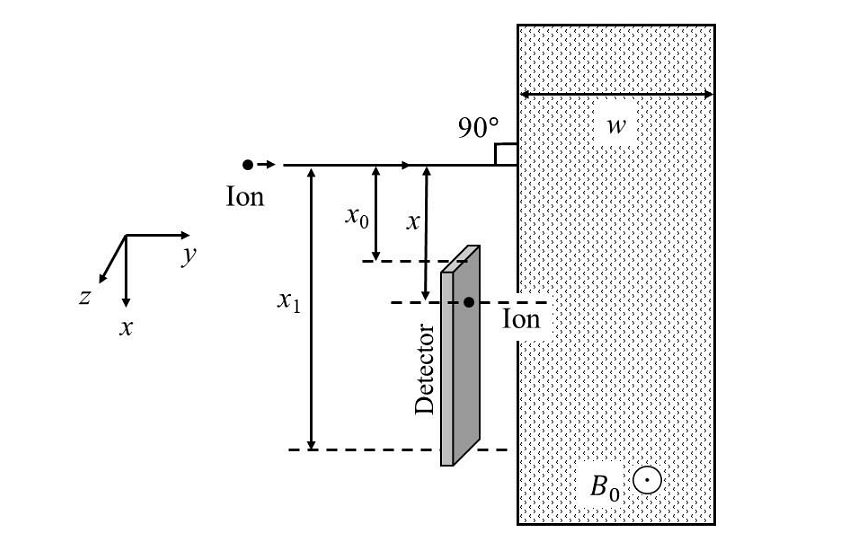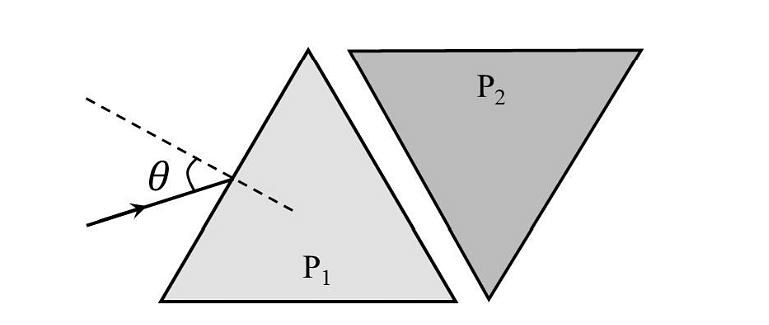Question:
A physical quantity $\vec{ S }$ is defined as $\vec{ S }=(\vec{ E } \times \vec{ B }) / \mu_{0}$, where $\vec{ E }$ is electric field, $\vec{ B }$ is magnetic field and $\mu_{0}$ is the permeability of free space. The dimensions of $\vec{ S }$ are the same as the dimensions of which of the following quantity(ies)?
A physical quantity $\vec{ S }$ is defined as $\vec{ S }=(\vec{ E } \times \vec{ B }) / \mu_{0}$, where $\vec{ E }$ is electric field, $\vec{ B }$ is magnetic field and $\mu_{0}$ is the permeability of free space. The dimensions of $\vec{ S }$ are the same as the dimensions of which of the following quantity(ies)?
Updated On: Jun 5, 2024
- $\frac{\text { Energy }}{\text { Charge } \times \text { Current }}$
- $\frac{\text { Force }}{\text { Lenght } \times \text { Time }}$
- $\frac{\text { Energy }}{\text { Volume }}$
- $\frac{\text { Power }}{\text { Area }}$
Hide Solution
Verified By Collegedunia
The Correct Option is D
Solution and Explanation
D
$\frac{\text { Power }}{\text { Area }}$
Was this answer helpful?
1
0
Top Questions on Electromagnetic waves
- A positive, singly ionized atom of mass number \(A_M\) is accelerated from rest by the voltage \(192 V\). Thereafter, it enters a rectangular region of width 𝑤 with magnetic field \(\bar{B_0} = 0.1𝑘̂\)Tesla, as shown in the figure. The ion finally hits a detector at the distance 𝑥 below its starting trajectory. [Given: Mass of neutron/proton =\((5/3) × 10^{−27}\) kg, charge of the electron \(= 1.6 × 10^{−19} C.\)]

Which of the following option(s) is(are) correct?- JEE Advanced - 2024
- Physics
- Electromagnetic waves
- The property which is not of an electromagnetic wave travelling in free space is that :
- NEET (UG) - 2024
- Physics
- Electromagnetic waves
- A source produced electromagnetic wave of frequency 60MHz. Find the wavelength of this wave in air.
- JEE Main - 2024
- Physics
- Electromagnetic waves
- Calculate the average energy density of an electromagnetic wave whose electric field is oscillating with amplitude \(50 \;V/m\) and frequency \(5 \times10^{10}\) \(Hz\) :
- JEE Main - 2024
- Physics
- Electromagnetic waves
- An electromagnetic wave has electric field given by \(\overrightarrow E = (9.6 \hat j)sin \bigg[2π\; {30 × 10^6t -\frac{1}{10} x}\bigg]\), \(x\) and \(t\) are in SI units. The maximum magnetic field is
- JEE Main - 2024
- Physics
- Electromagnetic waves
View More Questions
Questions Asked in JEE Advanced exam
- Let \(S=\left\{\begin{pmatrix} 0 & 1 & c \\ 1 & a & d\\ 1 & b & e \end{pmatrix}:a,b,c,d,e\in\left\{0,1\right\}\ \text{and} |A|\in \left\{-1,1\right\}\right\}\), where |A| denotes the determinant of A. Then the number of elements in S is _______.
- JEE Advanced - 2024
- Matrices
- A block of mass \(5 kg\) moves along the \(x-\)direction subject to the force \(F = (−20x + 10) N,\) with the value of \(x \) in metre. At time \(t = 0 s,\) it is at rest at position \(x = 1 m\). The position and momentum of the block at \(t = (\pi/4)\) s are
- JEE Advanced - 2024
- Work-energy theorem
- Two equilateral-triangular prisms \(P_1 \)and \(P_2\) are kept with their sides parallel to each other, in vacuum, as shown in the figure. A light ray enters prism \(P_1\) at an angle of incidence 𝜃 such that the outgoing ray undergoes minimum deviation in prism \(P_2\). If the respective refractive indices of \(P_1\) and\( P_2\) are \(√ 3 /2\) and \(√3\), then \(\theta = sin{−1}[\sqrt \frac{ 3}{ 2} sin ( \frac{\pi}{B} )],\) where the value of \(\beta\) is ______.

- JEE Advanced - 2024
- Ray optics and optical instruments
- Let \(\overrightarrow{OP}=\frac{\alpha-1}{\alpha}\hat{i}+\hat{j}+\hat{k},\overrightarrow{OQ}=\hat{i}+\frac{\beta-1}{\beta}\hat{j}+\hat{k}\) and \(\overrightarrow{OR}=\hat{i}+\hat{j}+\frac{1}{2}\hat{k}\) be three vector where α, β ∈ R - {0} and 0 denotes the origin. If \((\overrightarrow{OP}\times\overrightarrow{OQ}).\overrightarrow{OR}=0\) and the point (α, β, 2) lies on the plane 3x + 3y - z + l = 0, then the value of l is _______.
- JEE Advanced - 2024
- Vector Algebra
- Let \(\vec{p}=2\hat{i}+\hat{j}+3\hat{k}\) and \(\vec{q}=\hat{i}-\hat{j}+\hat{k}\). If for some real numbers α, β and γ we have
\(15\hat{i}+10\hat{j}+6\hat{k}=α(2\vec{p}+\vec{q})+β(\vec{p}-2\vec{q})+γ(\vec{p}\times\vec{q})\),
then the value of γ is ________.- JEE Advanced - 2024
- Vector Algebra
View More Questions
Concepts Used:
Electromagnetic waves
The waves that are produced when an electric field comes into contact with a magnetic field are known as Electromagnetic Waves or EM waves. The constitution of an oscillating magnetic field and electric fields gives rise to electromagnetic waves.
Types of Electromagnetic Waves:
Electromagnetic waves can be grouped according to the direction of disturbance in them and according to the range of their frequency. Recall that a wave transfers energy from one point to another point in space. That means there are two things going on: the disturbance that defines a wave, and the propagation of wave. In this context the waves are grouped into the following two categories:
- Longitudinal waves: A wave is called a longitudinal wave when the disturbances in the wave are parallel to the direction of propagation of the wave. For example, sound waves are longitudinal waves because the change of pressure occurs parallel to the direction of wave propagation.
- Transverse waves: A wave is called a transverse wave when the disturbances in the wave are perpendicular (at right angles) to the direction of propagation of the wave.



